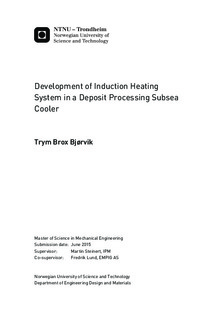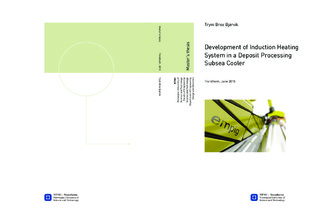| dc.description.abstract | Continuing the development subject to the pre-master project, the purpose of this master thesis was to properly address the implementation of an induction heating system into a compact embodiment of the EMPIG InFlow system, as described in the pre-master report, through conceptual development and preliminary feasibility assessments.
The principle of and technology related to electromagnetic induction heating was researched through literature and extensive dialogue with EFD Induction, a leading supplier of induction heating equipment and longtime cooperator of EMPIG, and a basic framework for current and future development was defined. The main limiting factors were identified as relating to the high frequency of the alternating current involved in the induction heating process, e.g. by complicating the transmission of electric power from the power supply to the induction coil. As thesis client, EMPIG was continuously involved, and had deciding authority, in the shaping of the project vision.
To realize the flow assurance functionality within the layered meandering pipe structure, a modular, mobile induction heater concept is proposed. The concept features a retrievable induction coil, carried by an all-electric actuated mechanism comprising sufficient degrees of freedom for the coil to traverse the entire pipeline unobstructed, except for the four vertical pipe bends which must be otherwise accommodated. Though no reasonable mechanism also able to traverse said vertical pipe bends has been identified thus far, a continuous scan heating work path across the respective horizontal layers of pipeline was enabled through an advantageous restructuring of pipes and supports.
The induction coil design featured in the concept proposed herein is not optimal with respect to heating efficiency, and will generate significant amounts of heat in operation. To minimize complexity, the opportunity of a passive cooling scheme for the coil was investigated through computational analyses of natural convection heat transfer from copper metal submerged in seawater. Though the credibility of said theoretical investigation has not been properly assessed, and it as such is insufficient for drawing a final conclusion, results were positive and substantiating for the belief that a passive cooling scheme is achievable.
Though introducing uncertainty to the concept in the form of additional moving parts, the proposed modular heater concept ensures redundancy through simultaneous application of multiple units, as well as fail-safe operation and possibly enables the secure in-field storage of both spare units and malfunctioning units awaiting intervention. | |

